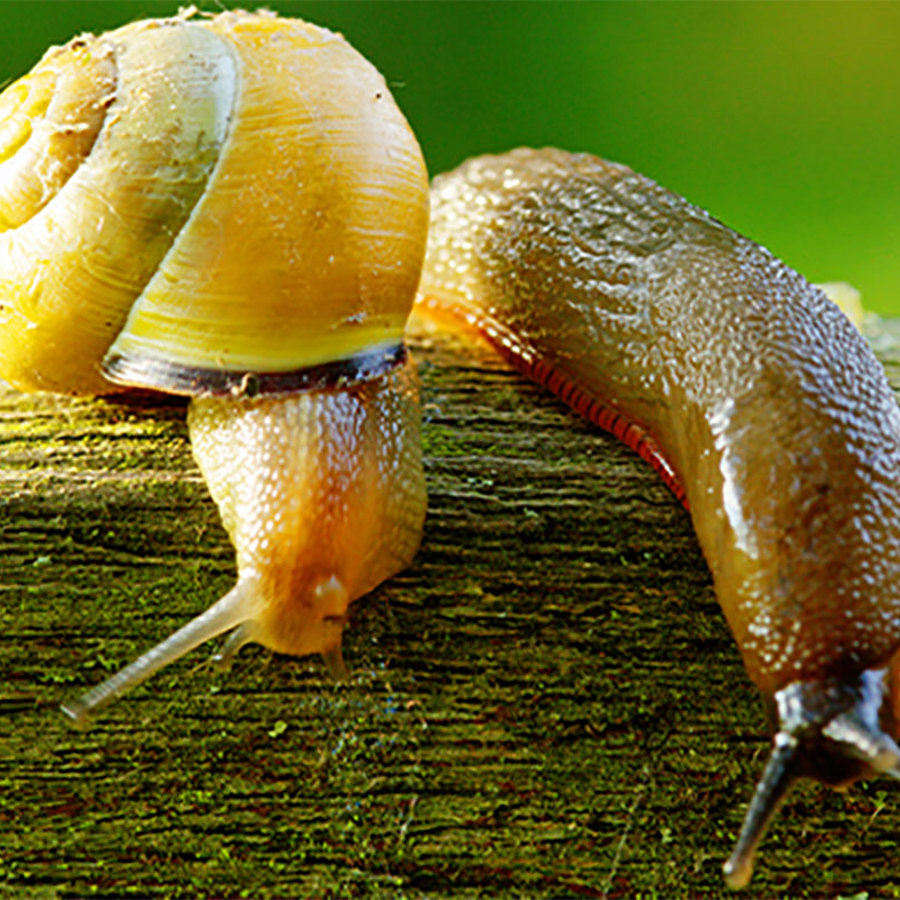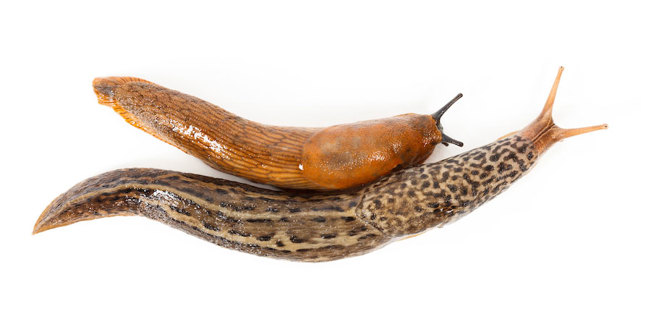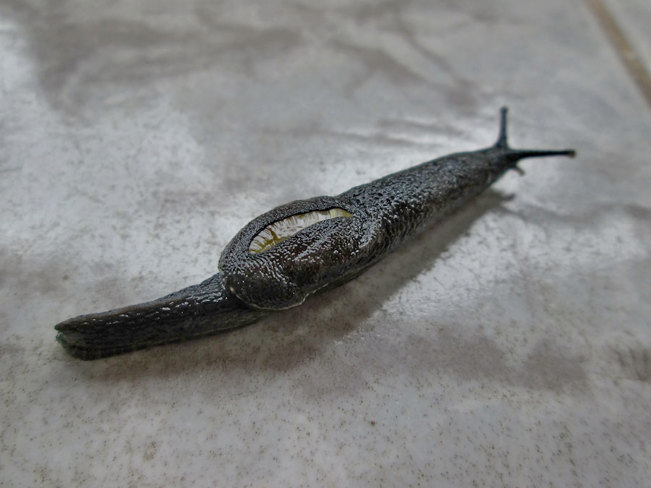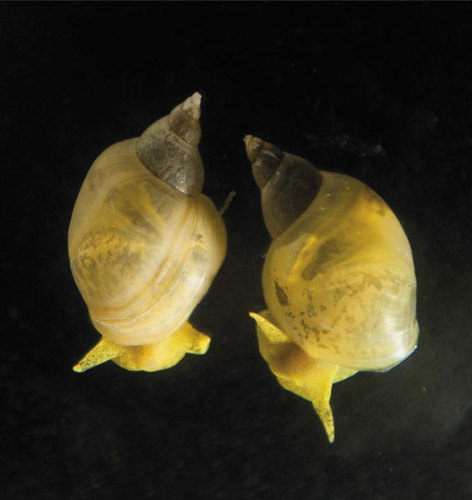
Can we make a Shell-less Snail or a Shell-y Slug?
April 2, 2022

- Related Topics:
- Complex traits,
- Comparing species,
- Quirky questions,
- Genetic engineering,
- Editor's choice
A curious adult from LA asks:
“Can CRISPR be used to reactivate the dormant gene that would give slugs snail shells or make shell-less snails?”
Although slugs just look like snails who lost their shells, it turns out that these are completely different species. Sadly, making the swap is not as easy as flipping a switch. There’s no single gene that we could simply turn on or off. We would have to make more than a few changes to the DNA of these species to make a snail lose its shell or make a slug grow a new home.
But because slugs and snails are pretty closely related, it would still be easier to make something like a slug grow a shell than it would be to make an unrelated animal like a bird or octopus grow one.
Evolution is Sluggish
Let's suppose that we didn’t care how long it would take or how many changes would be required, we still wanted to make a snail trade its shell with a slug. It turns out that evolution has already made this transformation, not just once, but many times over the past several hundred million years.
Evolution is a gradual process where genetic changes, called mutations, gradually accumulate. While many mutations don’t have an effect, others might make an important change. The result could be small like a slightly different color shell, or it could be big like having no antenna.
Over time these mutations can change the identity of the organism. This is how we got slugs. Slugs evolved from snails that gradually over time accumulated mutations that caused them to lose their shells.
And this didn’t just happen once. Instead, it looks like many different species of snails in many different places in the world independently lost their shells. Which led to many completely unrelated species of slugs!

It's still not completely clear whether there’s an evolutionary advantage to a snail losing its shell. It may be that there are certain environmental factors that can contribute to this change. If this is true, then changing a snail's environment might be enough to prevent the shell from forming.
In fact, there are a number of environmental triggers that have been discovered to prevent snails from growing proper shells. For example, raising snails in acidic seawater can cause a delay in shell formation.1 If you want to get even more extreme, exposure to the heavy metal platinum can cause snails to grow a completely internalized shell making them look kind of sluggish.2,3
So if we wanted a quick and dirty way of making a pseudo-slug, platinum might be the answer. The only problem is, these aren’t the healthiest critters in the world. They’re kind of sickly slugs since high levels of platinum are toxic.
If we wanted to do a better job of transforming snails into slugs we would want to use a gene editing tool like CRISPR. This would allow us to precisely modify specific genes, while leaving the rest untouched.
Since it's often easier to break things rather than build them, let's first think about how we could make a slug from a snail by preventing the shell from forming. If we could block a key shell gene or two from doing their job, we might be able to turn a snail into a slug. Lucky for us, gene editing tools like CRISPR are really good at breaking genes. The trick would be to figure out which gene(s) to break.
Shell-fish Genes
So what do we know about shell genes? How many changes happen to transform a snail into a slug? And most importantly for us, is there just one piece of DNA that controls shell formation or are there many?
One way you can figure this out is by looking at the in-between species. If there was just one shell switch, you’d expect shells to be all or nothing. They’re either a slug or a snail. Either they would have the shell DNA and therefore have shells, or they wouldn’t have the shell instructions and would be shell-less.
If we can identify what changed on the path from snail to slug, maybe we can identify which DNA is important for shell formation. So let's look and see, what’s on the evolutionary path between snail and slug?
Allow me to introduce you to the semi-slug! This girl has what looks like a shell on her back, but it’s too small for her to fit into. It's actually not even a real shell anymore since it's submerged beneath a layer of tissue called a mantle. She’s not quite a snail and not quite a slug either.

Looking at my friend the semi-slug gives you a hint that the ability to grow a shell might be a little bit more complex than we first thought. Having a shell is not an all or nothing trait. It looks like shell formation might be a bit complicated.
And it gets even more interesting. Scientists have learned that some slugs still have a shell… but on the inside of their bodies!
These in-between species might have some working genetic instructions for shells, but are missing some other important genetic pieces. Or maybe their shell-forming genes are functioning only half as well as they would in a regular snail.
But how many genes exactly are involved here? And what do they all do?
One important shell gene is dermatopontin, which codes for a protein that makes up part of the shell itself.4 Dermatopontin forms the blueprint for crystallization of the shell.
Another important gene is calmodulin, which affects how calcium is used. In snails, calmodulin turns out to be pretty important for shell formation since the shell is made up of mostly (90%!) calcium carbonate.5
But these aren’t the only important genes. In the sea snail Haliotis asinina, over a hundred proteins are believed to be involved in shell creation.6

And that’s not even the full story. It turns out that when these genes are turned on or off matters a lot too.7
In many snails, the shell formation genes are most active in the first few hours and days of development of these animals. If these genes aren’t working correctly during this period, the shell will be wimpy or won’t even form at all.
If you wanted to genetically engineer a shell-less snail, it might be sufficient to block a key gene or two from doing their job properly. Maybe breaking just a few key genes like dermatopontin or calmodulin would be enough to create a sluggish snail.
But giving a slug a shell might be a lot harder. We probably need to change a lot of genes to give a slug a functional shell. And we’d need those changes to work in exactly the right place, at exactly the right time.
If you’re looking for any shortcuts like we found for using platinum on snails, you’ll be disappointed. Sadly there’s no special water or mineral that has been found to prompt shell growth in slugs.
Shell Game
Once you know what genetic changes you want to make, you need to actually get your gene editing tool to make those changes.
This is no small task. Biologists have made genetic modifications in many different organisms from bacteria to mice, but what about snails or slugs? It can be hard to pioneer a system for modifying the genes of an unfamiliar organism.
It turns out we’re in luck. Meet Lefty, the world’s first CRISPR snail!8 In this case we have an example where scientists have introduced a mutation to a single gene in the snail genome. This gene controls the direction that a snail shell spirals. In its normal form, it causes the shell to spiral to the right, but in its mutated shorter form, this gene and a related gene causes leftward spiraling.9
This should give us hope that genetic modifications in snails are possible. So far no one has genetically modified slugs, so making those changes would likely take a bit more trial and error to get working.

What Shell I call You?
If evolution is any clue, it might be easier for snails to lose their shells than for slugs to gain them. Slugs have evolved from snails many separate times, but there are no records of a snail ever having evolved from a slug. We don’t know for sure, but it might be because there are so many different genes involved in shell formation. It's easier to mess up the coordination between all these genes working together to prevent shell formation, than it is to get them to work together again once they’ve forgotten how.
To get a slug to grow a shell, we’d likely have to modify more than a few different genes. And that would be the easy part. We would also have to make sure that these genes were expressed at the right time for a shell to successfully form. To do that, we’d likely have to modify still other genes!
Biology is beautiful and incredibly complicated. Sometimes altering a single gene can cause a big change like making a snail’s shell spiral the opposite direction. But other times, evolution works at a snail's pace.
Read More:
- Carnegie Museum of Natural History: What's So Good About Being a Slug?
- The New York TImes: It's a Lefty! Welcome to the World's First Crispr Snail Baby

Author: Erin Brooks
When this answer was published in 2022, Erin was a research assistant in the Departments of Genetics and Hematology studying the role of the gut microbiome in health and disease in Dr. Ami Bhatt’s laboratory. She wrote this while participating in the Stanford at The Tech program.
 Skip Navigation
Skip Navigation
